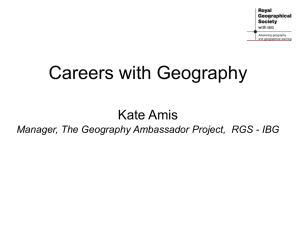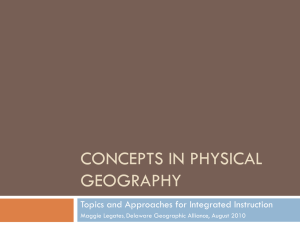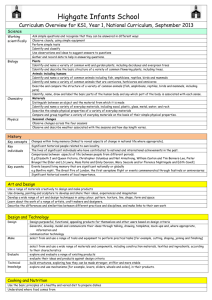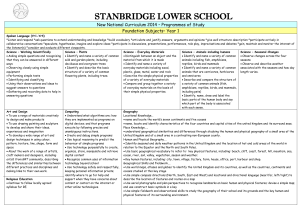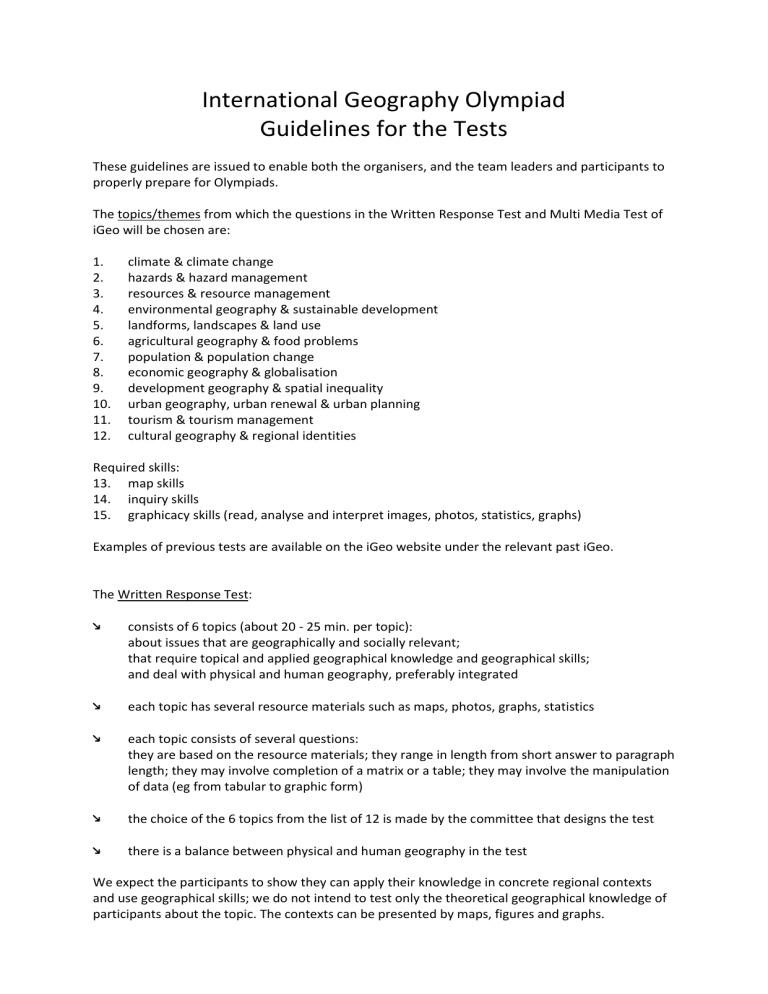
International Geography Olympiad Guidelines for the Tests These guidelines are issued to enable both the organisers, and the team leaders and participants to properly prepare for Olympiads. The topics/themes from which the questions in the Written Response Test and Multi Media Test of iGeo will be chosen are: 1. 2. 3. 4. 5. 6. 7. 8. 9. 10. 11. 12. climate & climate change hazards & hazard management resources & resource management environmental geography & sustainable development landforms, landscapes & land use agricultural geography & food problems population & population change economic geography & globalisation development geography & spatial inequality urban geography, urban renewal & urban planning tourism & tourism management cultural geography & regional identities Required skills: 13. map skills 14. inquiry skills 15. graphicacy skills (read, analyse and interpret images, photos, statistics, graphs) Examples of previous tests are available on the iGeo website under the relevant past iGeo. The Written Response Test: $ consists of 6 topics (about 20 - 25 min. per topic): about issues that are geographically and socially relevant; that require topical and applied geographical knowledge and geographical skills; and deal with physical and human geography, preferably integrated $ each topic has several resource materials such as maps, photos, graphs, statistics $ each topic consists of several questions: they are based on the resource materials; they range in length from short answer to paragraph length; they may involve completion of a matrix or a table; they may involve the manipulation of data (eg from tabular to graphic form) $ the choice of the 6 topics from the list of 12 is made by the committee that designs the test $ there is a balance between physical and human geography in the test We expect the participants to show they can apply their knowledge in concrete regional contexts and use geographical skills; we do not intend to test only the theoretical geographical knowledge of participants about the topic. The contexts can be presented by maps, figures and graphs. The Multi Media Test consists of: $ 40 items (about 1 - 2 min. per item, depending on complexity of source material) about issues that are geographically and socially relevant; that require topical and applied geographical knowledge and geographical skills; and deal with physical and human geography, either separately or integrated $ each item consists of a map and/or digital photo, film or graph and a short question $ the question is a multiple-choice question with 4 options $ the test will cover all 12 topics from the list $ there is a balance between physical and human geography in the test. For the Multi Media Test we are looking for questions that require basic geographical thinking skills, where the contestants analyse information in maps, diagrams or photographs. Thus, the Multi Media Test is not intended to test the ability of the contestants to reproduce geographical facts but to test their skills in geographical analysis. Another reason to stress skills instead of knowledge, is the fact that the geography curricula in the participating countries vary considerably. Therefore testing geographical skills that form the core of practically every curriculum is more appropriate than asking questions about isolated geographical facts. The ideal is to have a computer-based Multi Media Test so that all participants can manage their own time during the test. If that is not possible at a particular Olympiad we will project the questions on a big screen as well as provide all participants with a copy of the test questions. The Fieldwork Exercise consists of: 1. 2. 3. Observation and mapping Analysis of spatial issue in fieldwork area including additional data gathering Problem-solving exercise leading to a proposal including a spatial plan or map Step 1: a mapping exercise of (a part of) the fieldwork area: Skills that are required during the mapping exercise are: 1. 2. 3. 4. 5. observe name the observed phenomena locate the phenomena on the map use appropriate graphic symbols describe the phenomena in the map key, use scale and orientation Students could for instance be provided with a base map and asked to add information to it using appropriate cartographic skills. Step 2: in the fieldwork area there is a (real or hypothetical) spatial problem that will be presented to the participants. The case relates to physical and/or environmental planning. The case/problem will be introduced and documented to the participants as well as the procedures and conditions for working on the problem-solving exercise. This can be done in a number of ways: a presentation, a workshop, short excursions to the fieldwork area (or a similar area), gathering additional data in the field, etc. Step 3: on the basis of the mapping exercise and the analysis of all the information about the case, the participants have to design a spatial plan (map) that tackles the problem presented, and give an explanation of the choices made. The explanation needs to show that the participant has understood the nature of the problem and made connections between the properties/qualities of the fieldwork area and the suggested spatial plan. In the explanation the use of graphic material (diagrams, photos, graphs, statistics) is preferred over lengthy texts. The map (spatial plan) is mandatory; the choice of the nature of the additional information is up to the participants. The criteria for marking the final product will be explained to the participants beforehand. The following products will be marked: $ the result of the mapping exercise: a map of (a part of) the fieldwork area $ the result of the problem-solving exercise: it includes a short analysis of the nature of the problem, objectives of the proposal, visualisation of the proposed solution in the form of a map or plan, an explanation and underpinning of suggested plan/measures/activities. Required skills: 1. mapping skills (read, analyse, interpret and produce maps) 2. inquiry and problem solving skills 3. graphicacy skills (read, analyse, interpret and produce images, photos, statistics, graphs)

